Design and Mechanical Analysis of a Cam-Linked Planetary Gear System Seedling Picking Mechanism
Abstract
1. Introduction
2. Materials and Methods
2.1. Kinematic Equations of the Seedling Picking Mechanism
- 1.
- The displacement equation of the seedling picking tip point driven by the rotation of the planetary frame was analyzed, where the assumption of the sun gear speed is 0. Consequently, the planetary gear and planetary frame transmission ratios can be derived as follows:
- 2.
- The rotation speed of the sun gear, driven by the cam-linkage through the gear mesh, was analyzed and then driven by the seedling picking arm. The rotation angle of the sun gear was set as shown in Equation (4), which indicated that the rotation was divided into four stages corresponding to the two ascending and descending stages of the cam. Further, the total rotation angle of one ascending and descending stage was 180°, that is, β3 + β4 = π.
2.2. Optimization Objectives and Variables
- The trajectory of the withdrawal of the seedling needle from the seedling tray should be approximately straight, and as vertical as possible with the cavity tray. The attitude of the withdrawal arm should remain unchanged. Further, the length of the straight section of the withdrawal trajectory should not be less than that of the seedling tray; otherwise, the seedling tray interferes with the seedling feeding mechanism.
- To ensure the success rate during the process of seedling picking, the tip of the seedling picking needle should be inserted into the seedling substrate of the seedling tray at a depth of not less than 35 mm. Moreover, it should not collide with the cavity tray.
- The minimum distance between the two pick-up arms during operation should be greater than 20 mm to ensure that the potted seedling does not interfere with the other pick-up arm when holding the seedling.
- When inserting the seedling needle into the cavity tray, the angle between the seedling needle and seedling should be in the range of 10–30° to ensure that the seedling needle does not cause damage when inserting the seedling into the pot. Moreover, this also ensures that it does not damage the stem and leaves of the seedling.
- To not collide with the wall of the seedling tray during seedling picking, the width of the loop of the seedling picking track should be less than 10 mm, which can reduce the damage of the seedling picking targeting the substrate.
2.3. Optimization Results
3. Simulation and Analysis of Seedling Picking Mechanism
3.1. Kinematic Simulation of Seedling Picking Mechanism
3.2. Modal Analysis of Seedling Picking Mechanism
4. Experiment and Analysis
4.1. Verification of the Trajectory of the Seedling Picking Mechanism
4.2. Analysis of Seedling Picking Tests by Seedling Picking Institutions
5. Conclusions
- This study proposed a seedling picking mechanism for a cam-linked planetary gear system, analyzed its working principle and structural characteristics, established the kinematic model of the mechanism, and developed computer-aided design optimization software through VB. Further, a set of structural parameters satisfying the target parameters was derived through human–computer interaction, and three-dimensional modeling was conducted according to the parameters. The motion of the seedling picking mechanism was simulated using Adams, and the simulated trajectory of the tip of the seedling picking needle was compared with the theoretical trajectory to verify the feasibility of the theoretical design.
- Ansys was used to perform finite element analysis on the model of the seedling picking mechanism. Through comparisons of the meshing frequency of the gear with the modal frequency, the analysis found that the meshing frequency of the gear was far away from the first six-order modal frequencies of the seedling picking mechanism, which proved that the seedling picking mechanism did not produce resonance under the working condition of 120 plants/min.
- A test bench for the seedling picking mechanism was built, and an idle experiment was conducted to compare the theoretical, simulated, and actual trajectories to verify the reliability of the theoretical design. Thereafter, a seedling picking test was conducted. With an increase in speed, the success rate of seedling picking decreased and the rate of substrate fragmentation increased. Thus, the results showed that the seedling picking mechanism yielded good results and met the design requirements.
Author Contributions
Funding
Institutional Review Board Statement
Data Availability Statement
Conflicts of Interest
References
- Cui, W.; Zhao, L.; Liu, L.J.; Liu, Z.J.; Zhao, J.H.; Zhao, Z.B. Kinematic analysis and experiment of rotary pick-up mechanism on seedling pick-up device. J. Agric. Mach. 2020, 51, 79–84. [Google Scholar]
- Xue, X.; Li, L.; Xu, C.; Li, E.; Wang, Y. Optimized design and experiment of a fully automated potted cotton seedling transplanting mechanism. Int. J. Agric. Biol. Eng. 2020, 13, 111–117. [Google Scholar] [CrossRef]
- Zhou, M.; Shan, Y.; Xue, X.; Yin, D. Theoretical analysis and development of a mechanism with punching device for transplanting potted vegetable seedlings. Int. J. Agric. Biol. Eng. 2020, 13, 85–92. [Google Scholar] [CrossRef]
- Yao, S.S.; Liu, J.X.; Zeng, J.X.; Shi, Q.; Zhao, C.Y.; He, X. Design of taking-combined-with-vibration-type seedlings unloading mechanism of vegetable transplanter. Agric. Equip. Veh. Eng. 2020, 60, 70–73. [Google Scholar]
- Zhang, Z.G.; Cao, W.B.; Wang, Q.; Zhang, P. Development status and prospect of plug seedlings automatic transplanting machine. Agric. Mech. Res. 2013, 35, 237–241. [Google Scholar]
- Hu, M.J.; Yin, W.Q.; Hu, F.; Qian, Y. Development of test system for automatic pick-up plug seedlings. J. Nanjing Agric. Univ. 2011, 34, 122–126. [Google Scholar]
- Han, C.J.; Yang, W.Z.; Zhang, X.J.; Guo, H.; Yin, W.Q. Design and test of automatic feed system for tray seedlings transplanter. J. Agric. Eng. 2013, 29, 51–61. [Google Scholar]
- Feng, S.J.; Wu, M.L.; Yan, B.; Quan, W. Research status and prospect of seedling pick-up device of pot seedling transplanter. Agric. Mech. Res. 2020, 42, 1–9. [Google Scholar]
- Ji, J.T.; Cheng, Q.; Jin, X.; Zhang, Z.H.; Xie, X.L.; Li, M.Y. Design and test of 2ZLX-2 transplanting machine for oil peony. Int. J. Agric. Biol. Eng. 2020, 13, 61–69. [Google Scholar] [CrossRef]
- Ji, J.; Cheng, Q.; Zhao, B.; Ji, J.T.; Li, M.Y. Design and test of 2ZYM-2 potted vegetable seedlings transplanting machine. Int. J. Agric. Biol. Eng. 2020, 13, 101–110. [Google Scholar]
- Zhou, M.L.; Hua, Z.Y.; Wang, J.Y.; Wang, L.; Zhao, Y.; Yin, D.Q. New type of transverse moving box mechanism for pot seedling transplanting machine. Int. J. Agric. Biol. Eng. 2018, 11, 70–75. [Google Scholar] [CrossRef]
- Wang, M.M.; Song, J.S.; Liu, C.L.; Wang, Y.L.; Sun, Y.P. Design and experiment of crank rocker type clamp seedlings mechanism of vegetable transplanter. J. Agric. Eng. 2015, 31, 49–57. [Google Scholar]
- Choi, W.C.; Kim, D.C.; Ryu, L.H.; Kim, K.U. Development of a seedling pick–up device for vegetable transplanters. Trans. ASAE 2002, 45, 13. [Google Scholar]
- Kang, T.G.; Kim, Y.K.; Jun, H.J.; Choi, L.S. Analysis of pick-up mechanism for automatic transplanter (I). J. Agric. Life Sci. 2017, 51, 187–192. [Google Scholar] [CrossRef]
- Xu, L.M.; Zhang, T.Z.; Shi, Z.Q. Design on the picking seedling machinery in the maize auto-transplanter. J. China Agric. Univ. 2000, 5, 58–60. [Google Scholar]
- Li, H.; Cao, W.B.; Li, S.F.; Fu, W.; Liu, K.Q. Kinematic analysis and test on automatic pick-up mechanism for chili plug seedling. J. Agric. Eng. 2015, 31, 20–27. [Google Scholar]
- Yu, G.H.; Liu, B.H.; Zhao, Y.; Sun, L.; Xie, Y.L. Kinematic principle analysis of transplanting mechanism with planetary elliptic gears in automatic vegetable transplanter. J. Agric. Mach. 2011, 42, 53–57. [Google Scholar]
- Yu, G.H.; Chen, Z.W.; Zhao, Y.; Sun, L.; Ye, B.L. Study on vegetable plug seedling pick-up mechanism of planetary gear train with ellipse gears and incomplete non-circular gear. J. Mech. Eng. 2012, 48, 32–39. [Google Scholar] [CrossRef]
- Tong, J.H.; Yu, G.H.; Zhu, Y.P.; Ye, B.L.; Zheng, C.; Huang, J.H. Design and experiment of three-arms rotary vegetable plug seedling pick-up mechanism. J. Agric. Mach. 2019, 50, 113–121. [Google Scholar]
- Ye, B.L.; Yu, G.H.; Chen, Z.W.; Zhao, Y. Kinematics modeling and parameters optimization of seedling pick-up mechanism of planetary gear train with eccentric gear and non-circular gear. J. Agric. Eng. 2011, 27, 7–12. [Google Scholar]
- Ye, B.L.; Li, L.; Yu, G.H.L.; Liu, A.; Zhao, Y. Dynamics analysis and test of rotary pick-up mechanism for vegetable pot-seedling. J. Agric. Mach. 2014, 45, 70–78. [Google Scholar]
- Liu, J.G.; Yu, G.H.; Tong, Z.P.; Hua, Y. Design and experimental study of a planetary gearing mechanism based on twice unequal amplitude transmission ratio. Int. J. Agric. Biol. Eng. 2022, 15, 155–163. [Google Scholar] [CrossRef]
- Yu, G.H.; Yu, T.F.; Ye, B.L.; Hu, H.J.; Wang, L.W. Design of a rotary plug seedling pick-up mechanism. J. Mech. Eng. 2015, 51, 67–76. [Google Scholar] [CrossRef]
- Xiang, L.; Zhao, Y.; Liu, L.L. Modal analysis of a certain loader gearbox. S. Agric. Mach. 2022, 53, 134–136. [Google Scholar]
- Guo, H.W.; Chen, C.Z. Modal analysis for transmission of a pure electric vehicle. Noise Vib. Control 2018, 38, 388–391. [Google Scholar]


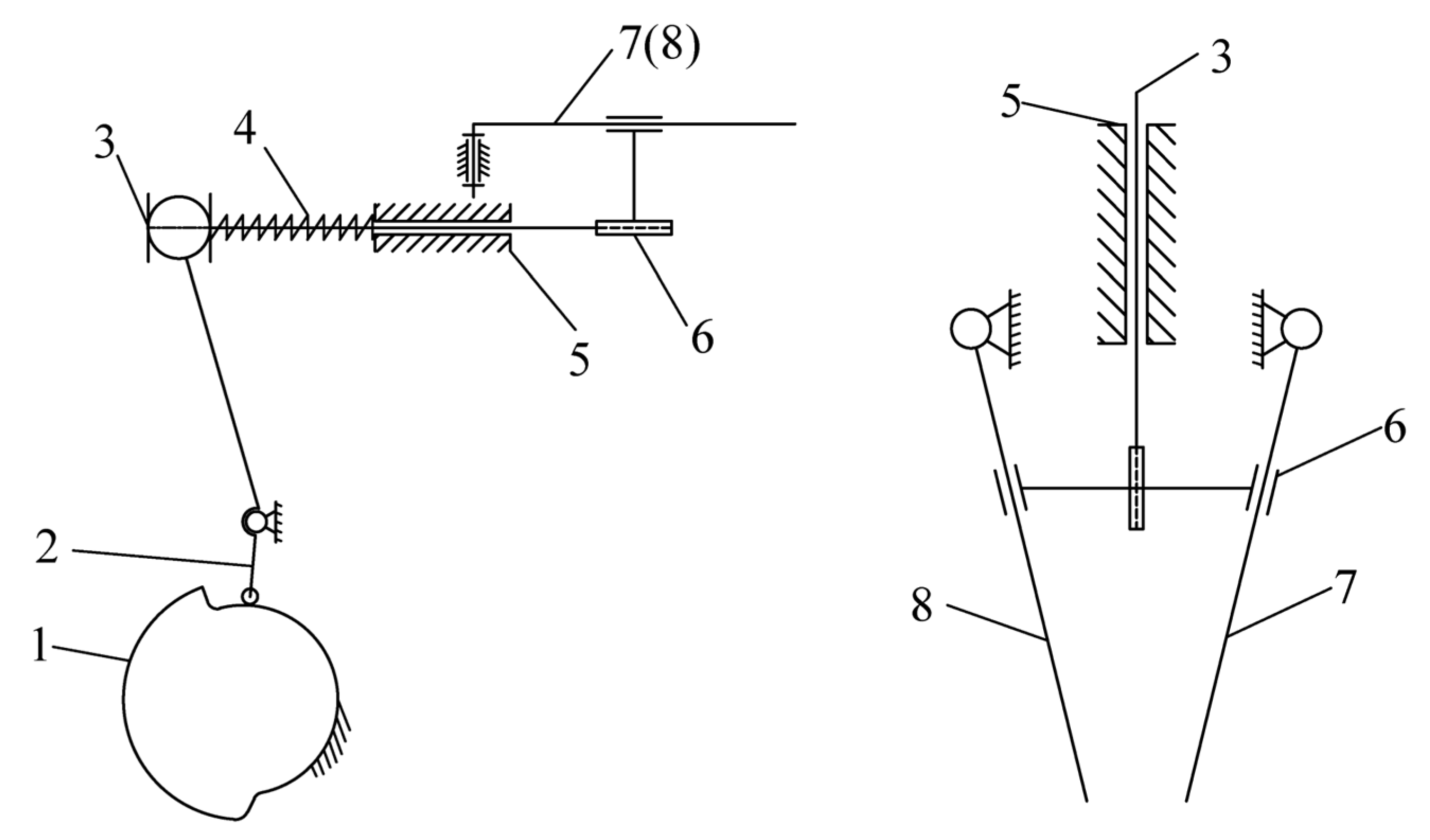
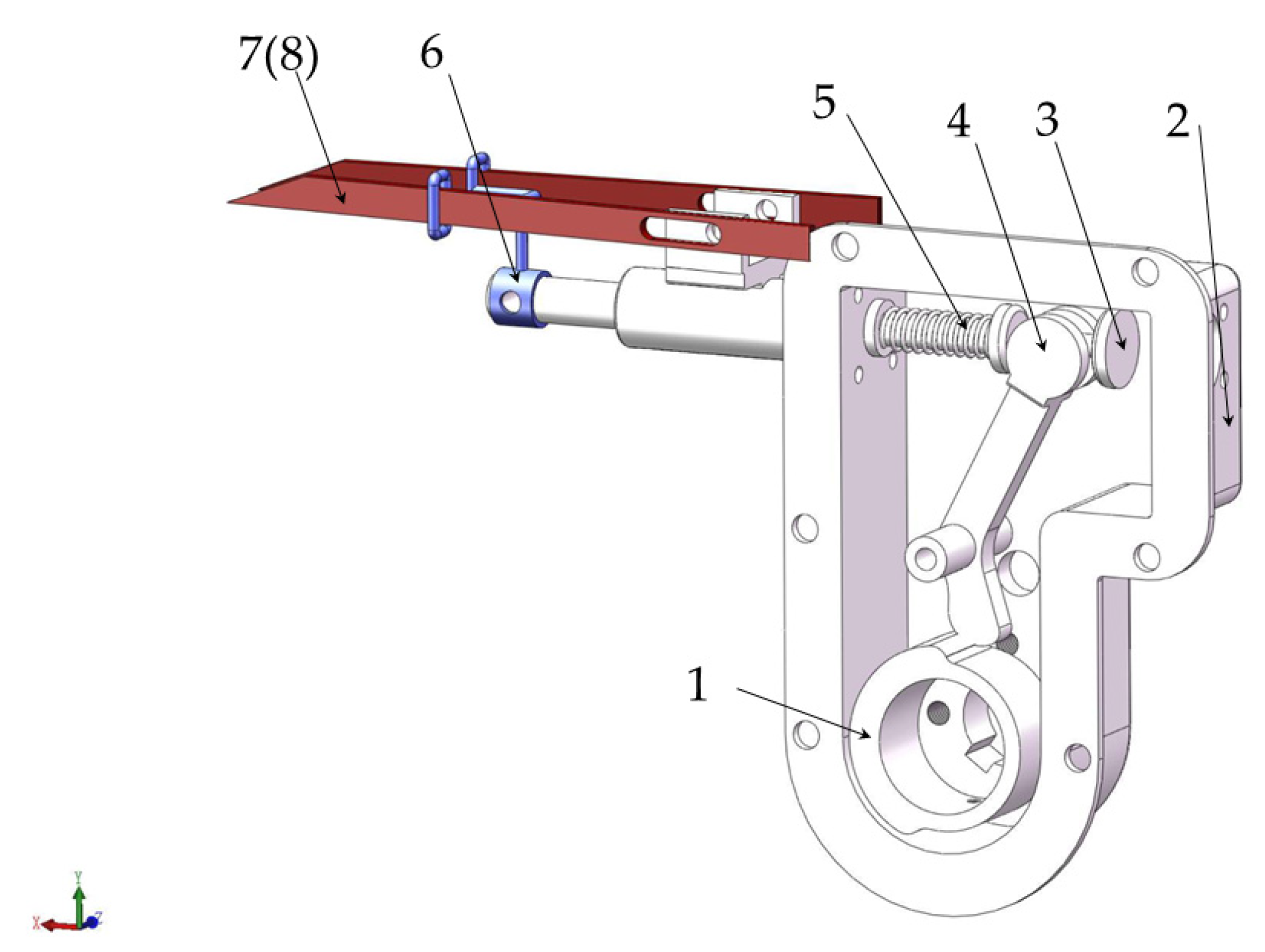
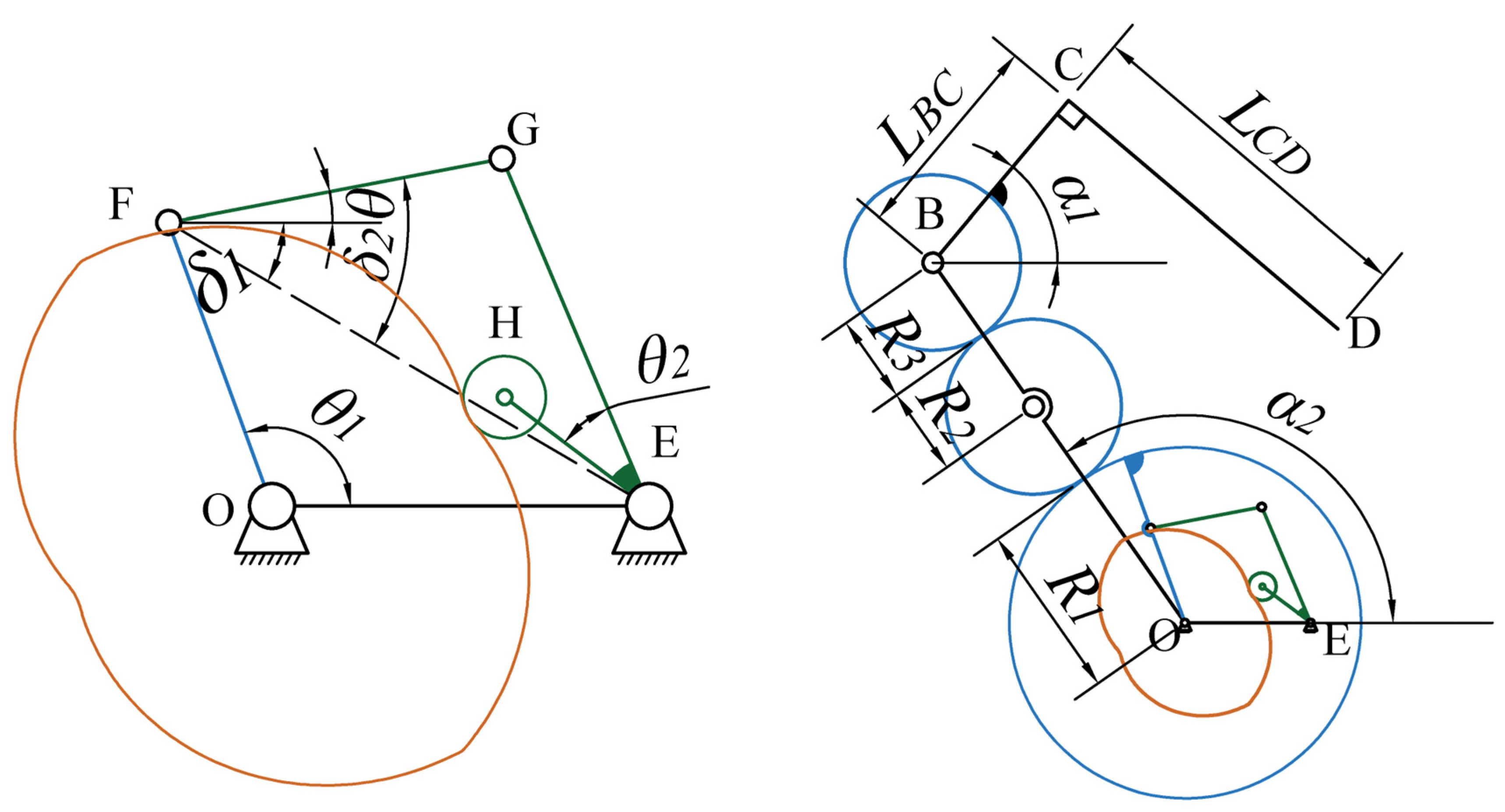
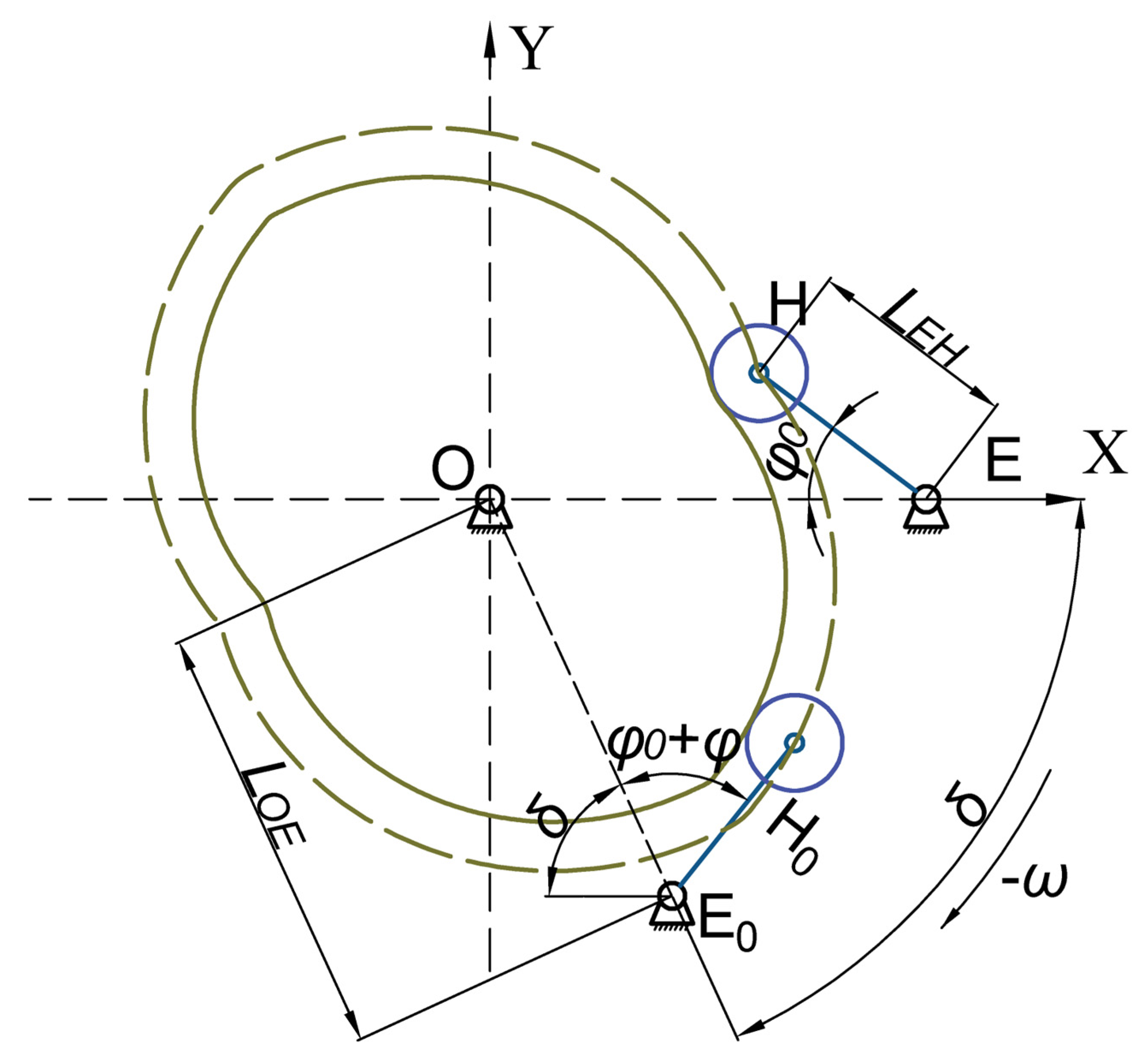
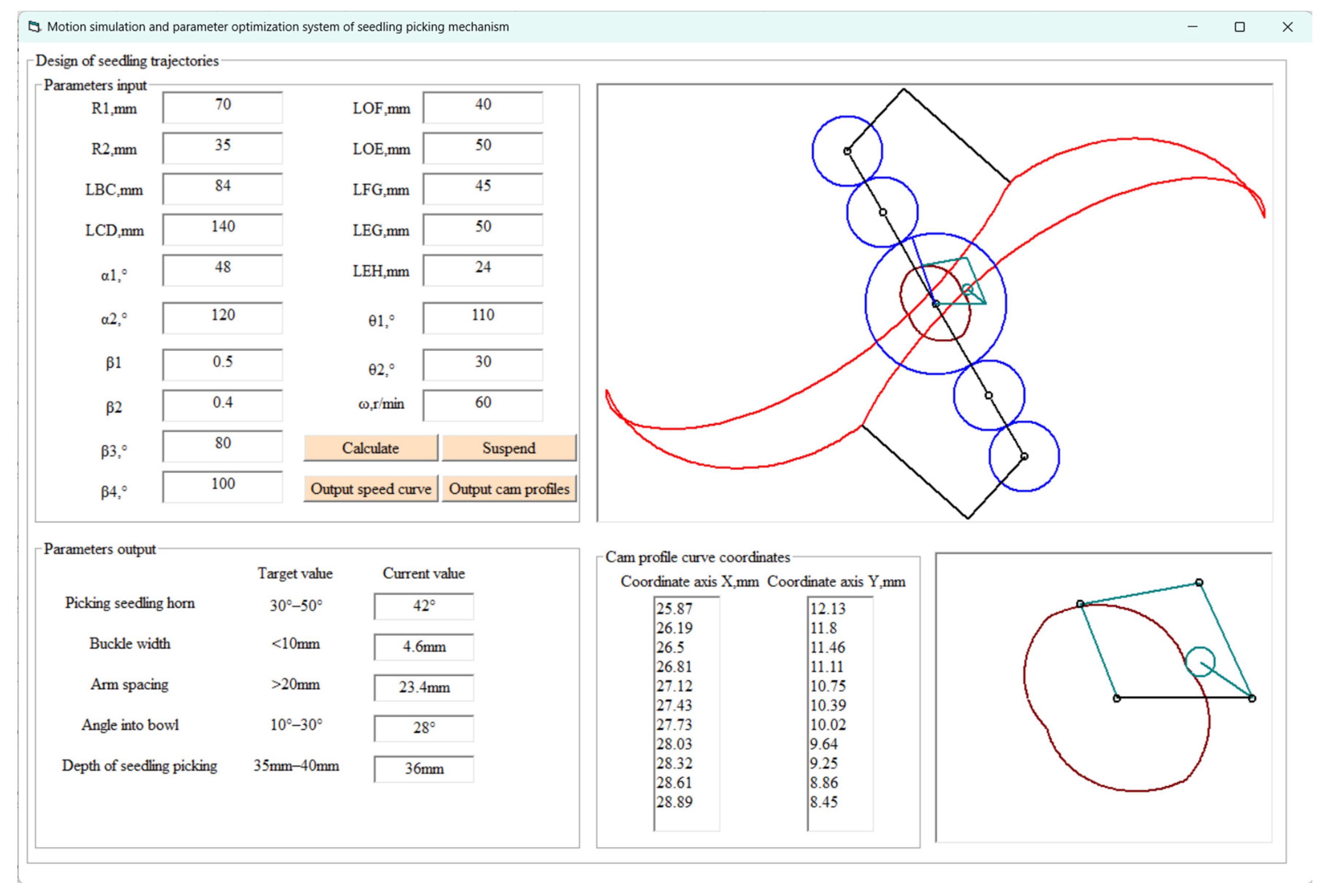
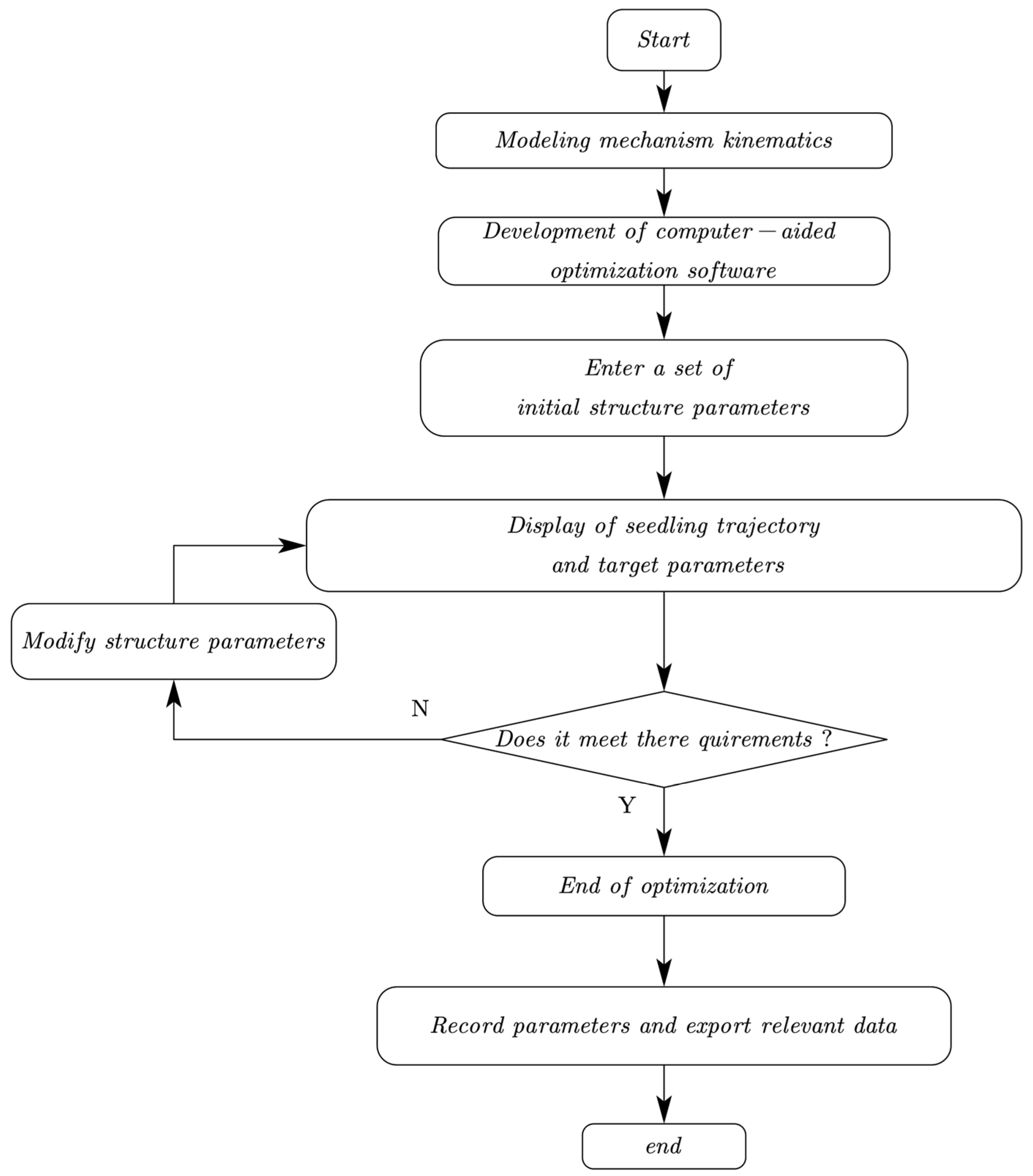
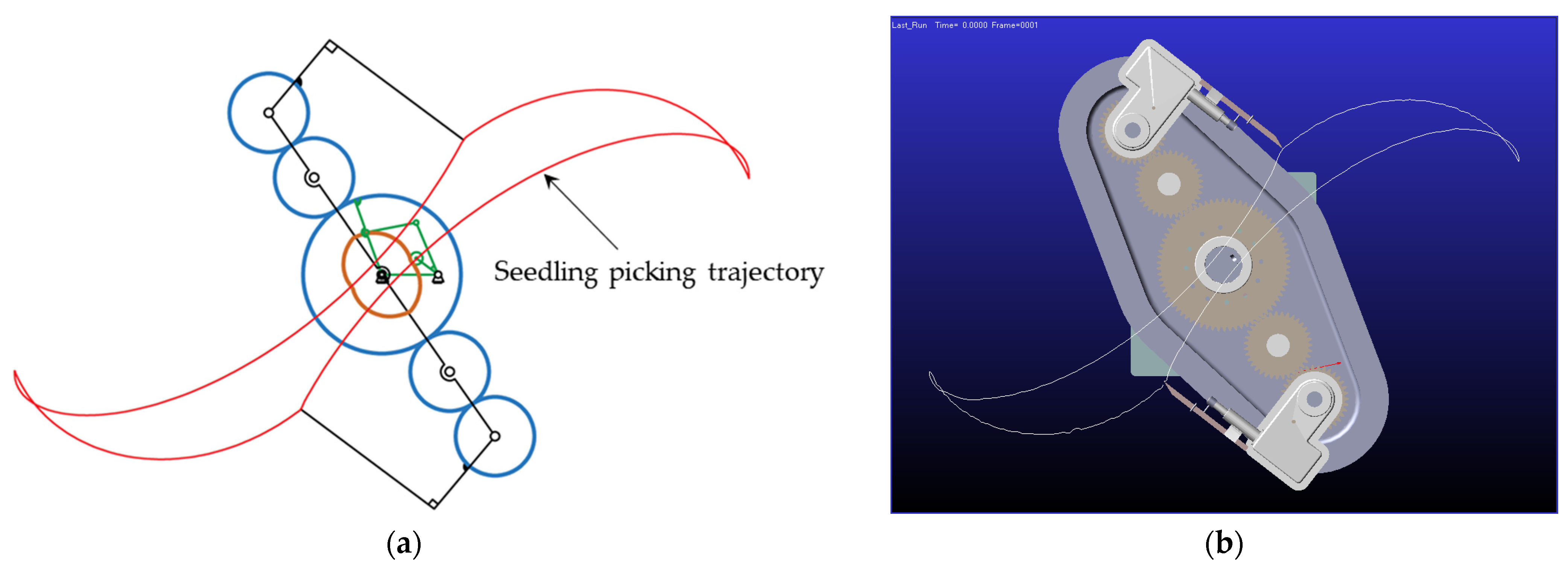






| Parameters | Final Value | Parameters | Final Value |
|---|---|---|---|
| R1 | 70 mm | β3 | 80° |
| R2 | 35 mm | LOF | 40 mm |
| LBC | 84 mm | LOE | 50 mm |
| LCD | 140 mm | LFG | 45 mm |
| α1 | 48° | LEG | 50 mm |
| α2 | 120° | LEH | 24 mm |
| β1 | 0.5 | θ1 | 110° |
| β2 | 0.4 | θ2 | 30° |
| Parts | Material | Modulus of Elasticity/(N/m2) | Poisson’s Ratio | Density/ (Kg/m3) |
|---|---|---|---|---|
| Gear | Nylon | 1.75 × 108 | 0.4 | 950 |
| Housing | Aluminum alloy | 7.1 × 1010 | 0.33 | 2770 |
| Others | Structural steel | 2.1 × 1011 | 0.29 | 7860 |
| Order | Modal Frequency/(Hz) | Order | Modal Frequency/(Hz) |
|---|---|---|---|
| 1 | 181.43 | 4 | 372.09 |
| 2 | 188.34 | 5 | 415.59 |
| 3 | 321.69 | 6 | 678.14 |
| Efficiency of Seedling Picking/(Plants/min) | Number of Seedlings | Number of Successful Seedling Picking | Number of Failed Seedling Picking | Success Rate of Seedling Picking/% | Rates of Substrate Damage/% |
|---|---|---|---|---|---|
| 90 | 128 | 125 | 3 | 97.66% | 4.43% |
| 100 | 128 | 123 | 5 | 96.09% | 6.73% |
| 110 | 128 | 120 | 8 | 93.75% | 9.57% |
| 120 | 128 | 116 | 12 | 90.63% | 14.37% |
Disclaimer/Publisher’s Note: The statements, opinions and data contained in all publications are solely those of the individual author(s) and contributor(s) and not of MDPI and/or the editor(s). MDPI and/or the editor(s) disclaim responsibility for any injury to people or property resulting from any ideas, methods, instructions or products referred to in the content. |
© 2023 by the authors. Licensee MDPI, Basel, Switzerland. This article is an open access article distributed under the terms and conditions of the Creative Commons Attribution (CC BY) license (https://creativecommons.org/licenses/by/4.0/).
Share and Cite
Jin, X.; Zhang, B.; Suo, H.; Lin, C.; Ji, J.; Xie, X. Design and Mechanical Analysis of a Cam-Linked Planetary Gear System Seedling Picking Mechanism. Agriculture 2023, 13, 810. https://doi.org/10.3390/agriculture13040810
Jin X, Zhang B, Suo H, Lin C, Ji J, Xie X. Design and Mechanical Analysis of a Cam-Linked Planetary Gear System Seedling Picking Mechanism. Agriculture. 2023; 13(4):810. https://doi.org/10.3390/agriculture13040810
Chicago/Turabian StyleJin, Xin, Bo Zhang, Hongbin Suo, Cheng Lin, Jiangtao Ji, and Xiaolin Xie. 2023. "Design and Mechanical Analysis of a Cam-Linked Planetary Gear System Seedling Picking Mechanism" Agriculture 13, no. 4: 810. https://doi.org/10.3390/agriculture13040810
APA StyleJin, X., Zhang, B., Suo, H., Lin, C., Ji, J., & Xie, X. (2023). Design and Mechanical Analysis of a Cam-Linked Planetary Gear System Seedling Picking Mechanism. Agriculture, 13(4), 810. https://doi.org/10.3390/agriculture13040810





